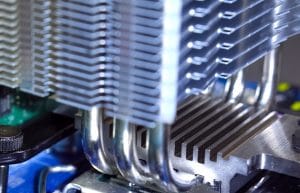 Most successful companies have always recognized the importance of efficient electrical thermal management processes to keeping their vital technologies running properly. Without them, their systems would quickly overheat or become too expensive to operate, and their large investments in more advanced technology would prove a loss. Today, that importance is even more apparent as even faster, more powerful, and in some cases, completely automated technologies have become implemented more frequently. To optimize on their investments and ensure their advanced applications continue running optimally, companies are benefiting significantly from the use of more natural, more eco-friendly, and nearly automated heat exchanger solutions.
Most successful companies have always recognized the importance of efficient electrical thermal management processes to keeping their vital technologies running properly. Without them, their systems would quickly overheat or become too expensive to operate, and their large investments in more advanced technology would prove a loss. Today, that importance is even more apparent as even faster, more powerful, and in some cases, completely automated technologies have become implemented more frequently. To optimize on their investments and ensure their advanced applications continue running optimally, companies are benefiting significantly from the use of more natural, more eco-friendly, and nearly automated heat exchanger solutions.
The challenges of automation and electrical cooling
Before the advent of heat exchangers, the use of traditional thermal management solutions such as air conditioners and air compressors was the most frequent solution to electrical cooling. These solutions became more cumbersome as technology has become more advanced, due largely to their high energy needs and need for space to accommodate large mechanical equipment. The trend in advancing technologies has always been to grow faster and more powerful, yet smaller, with each new iteration. One of the first challenges that heat exchangers helped overcome was providing adequate thermal management in a much more efficient and conservative manner, by transferring waste heat instead of relying on traditional methods of using chilled air.
A more sustainable method of managing waste heat
Heat exchangers operate by housing an eco-friendly cooling fluid, such as water, inside of a carefully designed unit (such as heat pipes or custom cold plates). The fluid is in a liquid state until it absorbs enough waste heat to change phase into a vapor, at which point it becomes much less dense and can travel rapidly away from the heat source through the pipes or cold plates. After releasing the heat in a custom heat sink, the fluid condenses back into liquid and is ready to absorb more heat. Because this occurs within a tightly sealed and contained loop, the cooling fluid can repeat the heat transfer process indefinitely, creating a highly sustainable and nearly automated cycle of constantly transferring waste heat.
Far-ranging benefits of streamlined heat transfer
The ability to continuously transfer waste heat within a tightly controlled loop, and using little more than a supply of water or other eco-friendly cooling fluid, has made heat exchangers an advantage over traditional solutions in several ways. Even for applications that aren’t automated, the significantly reduced energy needs of heat exchangers and the minimal or no need for routine maintenance has helped companies boost their thermal management efficiencies in key areas. For instance, in addition to making it easier to keep automated technologies properly and efficiently cooled, heat exchangers have also helped companies utilize natural heat transfer methods to facilitate other processes that can benefit from the use of waste heat (such as wastewater treatment, and more).
Learn about the advantages companies experience when thermal management is nearly automated. Call Noren Thermal Solutions in Taylor, TX, at 866-936-6736.







